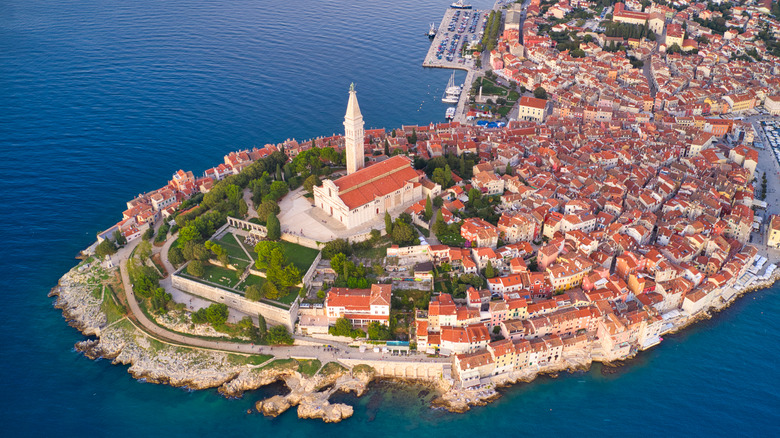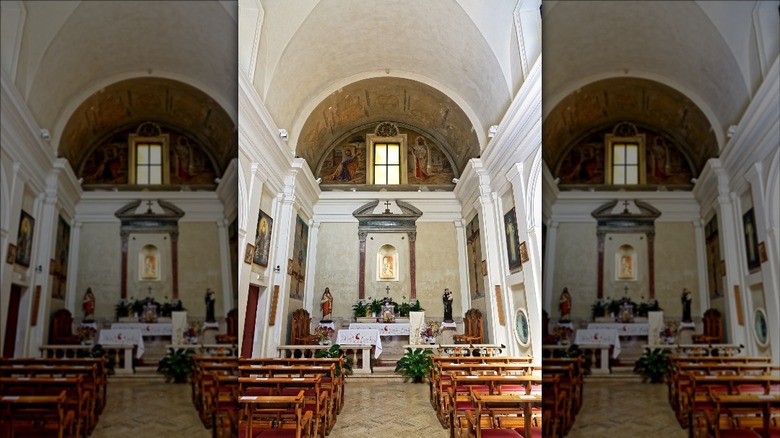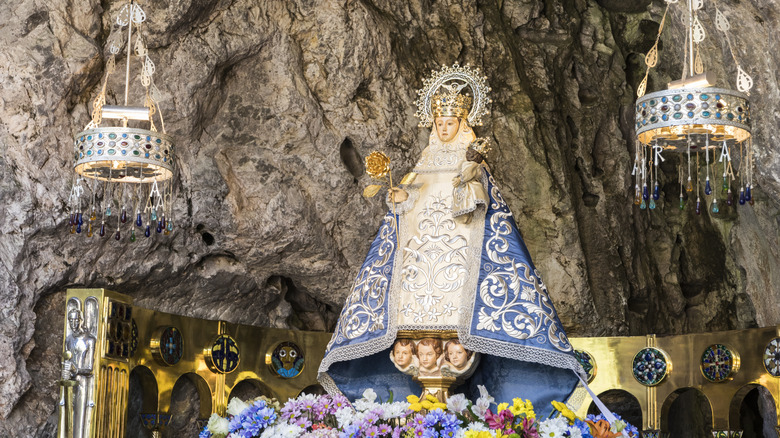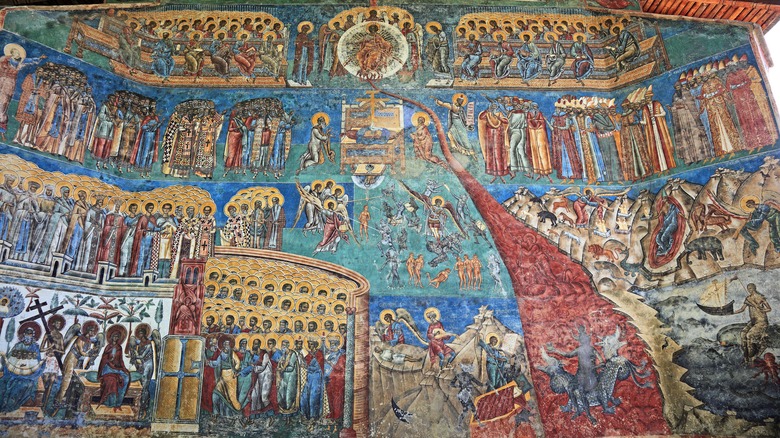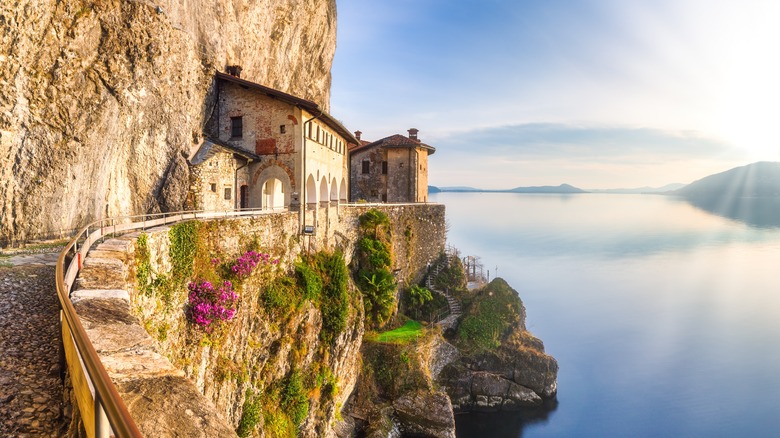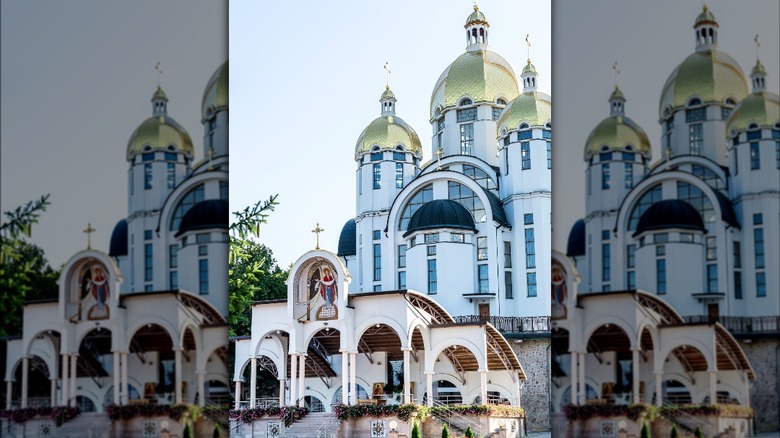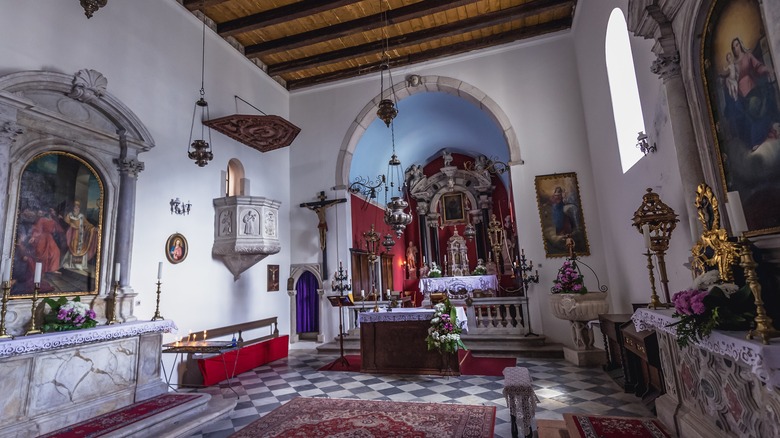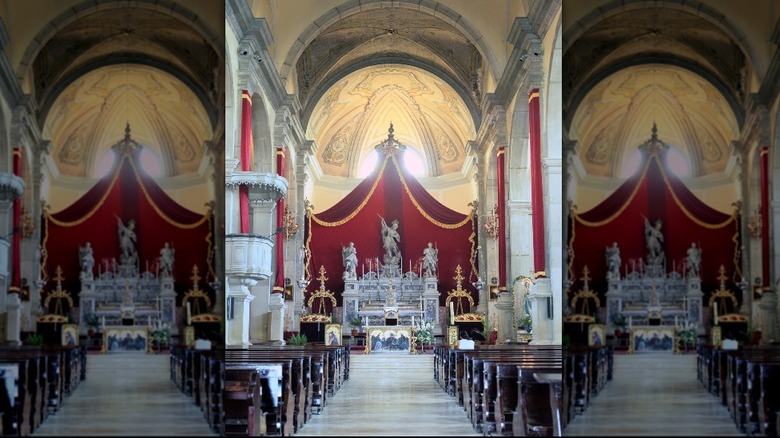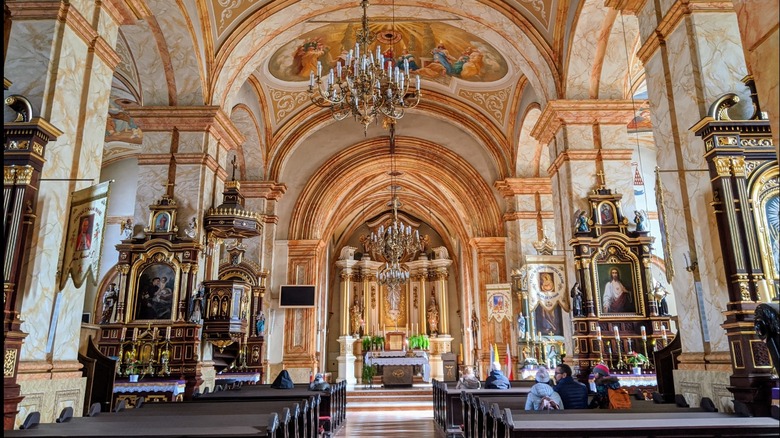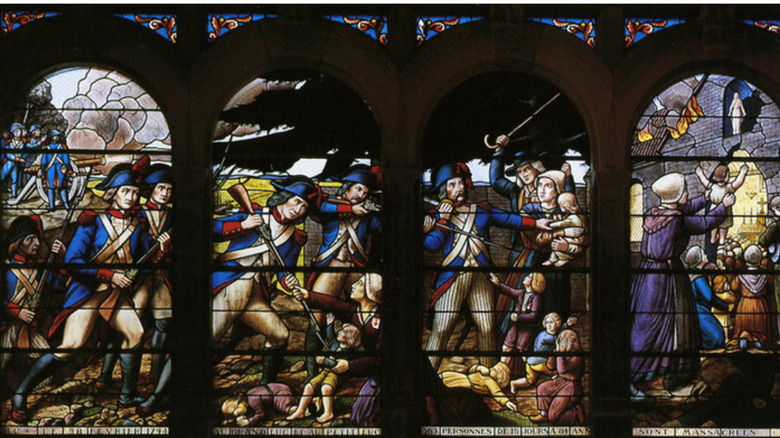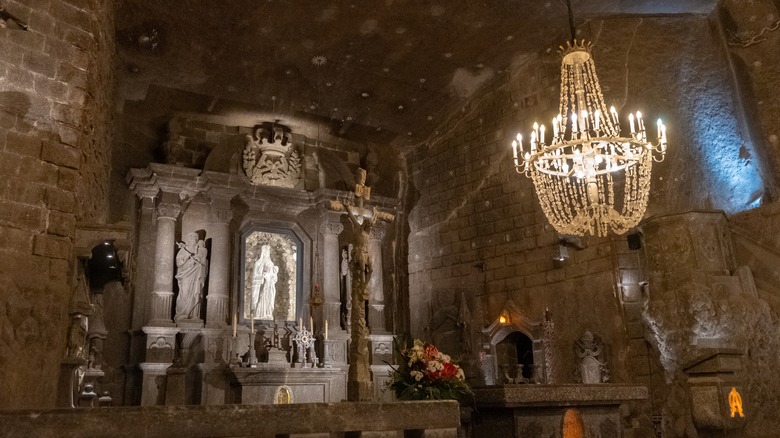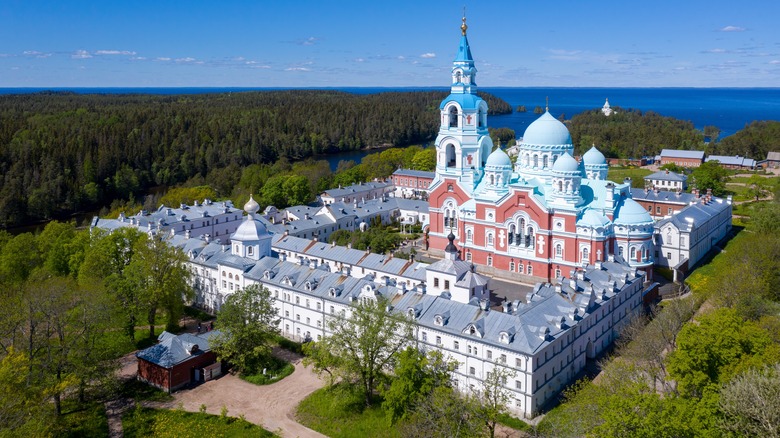The Most Breathtaking Hidden Gem Churches Across Europe
Visiting Europe's great cathedrals is no doubt a moving experience, regardless of one's religiosity, but the crowds and disrespectful behavior that occasionally accompany such visits can make them stressful, to say the least. If your goal is to enjoy some quiet time with God or to simply take in the history and culture in peace, you might have trouble with that in places like the Sagrada Familia or St. Peter's Basilica and its iconic view. It's understandable that people want to go — these are places where European history was made.
But scattered in Europe's more remote corners are numerous small churches that tell their own stories of greatness, often being sites connected to major historical events we might be familiar with, but might associate with large cities like Moscow or Venice or the Vatican rather than small villages or nondescript parish churches in major cities that tourists never touch. Here are 11 hidden gems of European Christendom you can visit — relatively crowd-free places whose art is beautiful and stories are truly epic and awe-inspiring — no matter your faith.
Santa Maria in Palmis
Want to walk where Jesus Christ walked without going to Israel? Unbeknownst to even most Catholics, there is a small, relatively unknown church in Rome that is doubly significant as a place where Jesus appeared in the flesh to put into action one of early Christianity's seminal events: The crucifixion of St. Peter.
The Church of Santa Maria in Palmis is colloquially known as the "Quo Vadis" Church. Today, it is located along the Appian Way, which travel expert Rick Steves recommends because of how it's never crowded. It does, however, have origins that date much further back. Infamous for denying Christ right after promising he would die with him rather than flee, Peter instead found himself fleeing death again, having been hounded out of Rome for preaching Christianity. On the road, he encountered Jesus. Legend has it that Peter asked Christ, "Lord, where are you going?" — or "Quo vadis" in Latin. Jesus responded that he was on his way to Rome to be crucified. St. Peter inferred that Jesus was asking him to turn back and prepare to die as Jesus did -– by crucifixion. Peter returned to Rome and ended up being crucified upside down.
Jesus is said to have left his footprints behind on the road as he was leaving, which the Catholic Church preserved. To see those, take a short six-minute bus ride to San Sebastian Outside the Walls.
Covadonga
The lesser-known Marian sanctuary of Covadonga in Asturias, Spain (aka "Green Spain" for its rolling hills), is centered around a small church built in a cave on Mt. Auseva. Don Pelayo, the first Asturian king, used the cave as a defensive position to defeat his Muslim opponents at the Battle of Covadonga in A.D. 722. Pelayo triumphed against superior enemy numbers thanks to the Virgin Mary's intervention –- the first Christian victory in the Reconquista. In gratitude, a church was built there in her honor. The statue of Our Lady of Covadonga, as the apparition is called, is located on the cave church's main altar. Rounding out the art and culture scene is a 19th-century basilica and an art museum, which also hosts the Virgin's magnificent crown.
For single women desiring marriage, the Fuente de los Siete Caños is a must. This little work of art, located directly below the cave, is fed by a pure spring directly out of the mountain. The water flows into a basin and then into seven fonts. Legend has it that if a woman drinks from all seven fonts in a row while holding her breath, she will get married within a year.
Located in the middle of Picos de Europa National Park, Covadonga is an outdoorsman's dream. Buses take tourists who want to hike to Lagos de Covadonga, where you can walk on trails past pristine lakes and idyllic fields filled with cows under mountain peaks covered in snow –- even in July. Just time it right –- the roads are sometimes closed to allow cowherds to move their animals up to pasture.
Voronet Monastery
Romania may be a dangerous country to drive in, but it boasts many breathtaking tourist destinations, including the region of Bucovina's painted monasteries. There are eight of them, but if you have to choose one, make it Voronet, whose blue-hued walls and legend make it stand out from the rest.
The Voronet Monastery began with Stefan cel Mare, the 15th-century prince of Moldavia known for his heroic defense of his lands against the Ottoman Turks. Legend has it that after a defeat against the Turks in 1476, Stefan was ready to surrender. But a hermit living near the site of Voronet urged him to keep fighting. Stefan listened, routing the Turks at Valea Alba the same year. For his victory, he earned the title "athlete of Christ." In 1488, he built Voronet in thanksgiving in three years, three months, and three days –- highly symbolic considering three is a Christian symbol of the Trinity and divine perfection.
The building's walls are covered in a gorgeous blue hue, giving it the nickname "The Blue Monastery." This color, which has yet to be replicated, provides a backdrop for the biblical scenes on both the interior and exterior walls. The scenes depict the Bible's most important stories, from Creation in Genesis to the Last Judgment in Revelation. Before the main altar is a gold-covered iconostasis and above, there's a dome painted with an icon of Jesus Christ looking down upon the congregation. It's not for nothing that Voronet is referred to as the "Sistine Chapel of the East."
Santa Caterina del Sasso
If you're traveling to Italy, you absolutely cannot miss Santa Caterina del Sasso, near Reno di Leggiuno in the region of Lombardy. The church is perched on a 52-foot-high cliffside overlooking the deep blue waters of Lago Maggiore. Legend tells that local merchant Alberto Besozzi was shipwrecked there in a vicious storm and prayed to St. Catherine for God's deliverance. Miraculously, he rode out the storm in a cave. In gratitude, he built a church in St. Catherine's honor, which was expanded over the centuries to the current complex. Visitors will be treated to a richly frescoed interior depicting saints (including Catherine), Christ, and an interpretation of the "danse macabre."
There is no best time to visit Santa Caterina – it depends on what you want to do. A summer visit means more tourists but allows you to enjoy the lake to its fullest, including activities such as kayaking, swimming, boating, and fishing. You can also take a boat to the monastery, which gives you a magnificent view from below as you approach the building. If you want views, however, a winter visit may be worth it. On a crisp, clear day, you can get great views of the deep-blue lake with the snow-covered Alps in the backdrop. And there is plenty to do too, at least around Christmastime when the decorations, lights, and Nativity scenes come out in the neighboring towns, such as Laveno-Mombello's annual underwater Nativity scene and celebration.
Zarvanytsia
Located in the Carpathian Mountains outside the Ukrainian city of Ternopil, the Marian shrine of Zarvanytsia is a testament to and a metaphor for Ukraine's faith and resilience in the face of war. The shrine was born in the fire and blood of the Mongol invasion of 1240. A fleeing monk fell asleep in the woods and was transported to an idyllic valley. Upon waking, he found himself in Zarvanytsia alongside an icon of Mary and Jesus. He placed the icon in a cave, which has been a place of pilgrimage ever since.
The sanctuaries have been sacked or shelled repeatedly, whether by raiding Tatars, Turks, or Austrian and Russian forces during World War I. Under the U.S.S.R., the atheist Soviet authorities tried to suppress the site. But the invaders never broke the faithfuls' spirits – each time, the sites have been rebuilt and pilgrims keep coming to admire the site's architecture and powerful symbolism.
Zarvanytsia's centerpiece is the Cathedral of the Mother of God, an open-faced, golden-domed hilltop church whose pews are not located in the building, but at the bottom of the hill. The nearby monastery has also been restored following decades of neglect under Soviet rule. It is a must-visit when conditions in Ukraine stemming from Russia's 2022 invasion improve –- Zarvanytsia is near Western Ukraine's cultural pearls of Lviv, Ternopil, and Ivano-Frankivsk, whose art and architecture take tourists over a century back to Austro-Hungarian imperial rule.
St. Nicholas' Church
For patriots of all places, persuasions, and stripes, this one's for you. Despite its spectacular lake and mountain views, Kotor is not the best-known Adriatic vacation spot among Americans, serving mostly as an alternative to Croatia's overtouristed Dubrovnik. The nearby town of Perast on the north side of the eponymous bay is even less so. This means fewer crowds in the town's principal attractions -– a handful of churches, chief of which is St. Nicholas' Catholic Church.
The church hosts a museum with examples of local and clerical embroidery, as well as Baroque sculpture, painting, and Eastern Christian iconography. The bell tower can be climbed for one euro for spectacular views of the Bay of Kotor, where you can contemplate the last thing Venetian soldiers might have seen in the moments before their country ceased to exist.
Once ranked among Europe's most powerful states, in 1797, The Republic of Venice (aka "La Serenissima") was a shadow of its former splendor. After Napoleon abolished the republic, Venice's garrisons along the eastern side of the Adriatic were left to surrender to Austria. Count Giuseppe de Viscovich did so in style with an emotional sendoff to La Serenissima. Rather than suffer the humiliation of surrendering Venice's final battle flag ("il Gonfalone"), he had it brought to St. Nicholas'. After an epic eulogy to the fallen republic, a kiss for the flag, and many tears, de Viscovich buried il Gonfalone with full honors under the church altar -– a powerful farewell to the state he had served so faithfully.
Basilica of St. Euphemia
The city of Rovinj (Rovigno in Italian) is easily recognizable for its hilltop position on a peninsula that juts out into the Adriatic. Hosting beautiful beaches, Italian architecture, and thriving contemporary and traditional art scenes, any trip to the city is incomplete without a visit to its crown jewel: The Basilica of St. Euphemia. The church sits at the very top of the promontory, providing fantastic views, gorgeous artwork, and a legendary story of its foundation.
The story of the basilica's namesake is steeped in legend. Virtually nothing is known about St. Euphemia other than that she was killed for being a Roman Christian in Chalcedon (modern Turkey) in A.D. 304 and buried there. Her body was transferred to Constantinople when the Persians sacked Chalcedon in 620, and then somehow ended up in Rovinj two centuries later. Per the story, locals found the sarcophagus washed up on the shore. After no one could move it, a boy and his two oxen miraculously managed it with the saint's help. The sarcophagus is the centerpiece of the current basilica. which was built in the 17th and 18th centuries under Venetian rule.
The basilica's artwork has been recently restored, and you can visit the studio of one of the artists responsible -– Rovingnese local Petra Turkovic. Her studio boasts an impressive array of religious art, and she is happy to discuss her work with any passers-by, time permitting. Afterward, you can enjoy the views and maybe a coffee overlooking the Adriatic –- or some wine in one of the region's many vineyards.
Basilica of Wadowice
As Poland's international profile increases, Americans are learning of wonders like the Wawel Cathedral in Krakow, a city known for its well-preserved medieval center, and the magnificent church fortress of Czestochowa, which is the home of the Black Madonna. The Basilica of Wadowice, however, has stayed under the radar, even though it's the home of Pope St. John Paul II (aka Karol Wojtyla).
Wadowice is not a quick bus stop for pictures – it's for tourists who really want to learn how John Paul II's early life in between the World Wars molded him into the pope we know. First up is the Wadowice Basilica. Dating back to the 14th century, this church is where John Paul II was baptized, received first communion, and was confirmed. Tourists can admire the painted ceilings and visit relics of saints like Fr. Maximilian Kolbe, a martyr of the Holocaust who volunteered to die in Auschwitz's starvation cell in place of a Polish man with a family.
But John Paul II's life cannot be properly understood by his religious upbringing alone -– his home life was equally important. The pontiff's childhood home in Wadowice hosts a museum filled with the Wojtyla family's photos, letters, and other personal effects. But its greatest attraction is an intimate look at Catholic-Jewish relations in interwar Poland through John Paul II's life; the future pontiff's family rented their apartment from the Jewish Balamuth family. Their story is also featured and paints a picture of real-life daily relations between members of the two faiths –- far more complicated than the un-nuanced narratives that tend to dominate popular histories. If you are lucky enough to visit around May 18, you will get to enjoy the town as it celebrates "Wadowice Days," a commemoration of JPII's birth and life.
Sts. Pierre et Paul
If you visit France around Bastille Day (July 14), you will hear odes to the French Revolution, which introduced Europe to the ideals of "liberty, equality, and fraternity." But not all French celebrate the Revolution, which to a tourist acquainted with the meta-narrative of the French Revolution might seem strange. How could people not want to celebrate the event that brought those ideals? To find out why, head to the Church of Sts. Pierre et Paul in Les Lucs-sur-Boulogne.
The 11th-century church's main attractions are the stained glass windows, which were installed in 1942. These give tourists a very different side of the French Revolution -– not of romantic liberation of peasants from an oppressive monarchy, but of bloodthirsty revolutionaries brutalizing the very people it claimed to represent. The scenes depict the Vendee War of 1793, in which Vendeean peasants and royalists, fed up with anti-Catholic sentiment, rebelled against Paris. Republican troops invaded Vendee, and as the scenes depict, showed no mercy. They indiscriminately bayoneted, shot, or drowned women and children, desecrated churches, and murdered priests who refused to abrogate their loyalty to Rome in favor of Paris.
For a visitor to Les Lucs-sur-Boulogne, seeing the stained glass might be an emotional, if not somewhat shocking moment -– especially considering the usually positive depiction of the French Revolution. But they are a reminder that historical meta-narratives are often only partly true, while historical truth is much more nuanced when it comes to the "good" and "bad" guys.
The Chapel of St. Kinga
Ditch all conceptions you have of what old, European Catholic churches should look like. Forget stone walls, marble or wood statues, and tilework – in St. Kinga's Chapel, a literal "hidden gem" located 101 meters underground in Poland's Wieliczka Salt Mine, sodium chloride is king.
The chapel is named after St. Kinga, the patroness of miners and of the countries of Poland and Lithuania. At first sight, the chapel will sparkle like glass in the light. But almost everything is actually made of salt. This includes the chandeliers, the altar, the statues of saints like St. Kinga and St. Joseph, and even the pictorial reliefs – in many cases salt-sculpture replicas of famous paintings like Leonardo DaVinci's Last Supper or depictions of biblical scenes like the Nativity of Christ.
Now, the question many a tourist might ask is, why on earth is there such a beautiful chapel in the middle of a salt mine? Chapels were actually a common feature of mines, which makes sense, considering mining was (and is) a dangerous line of work. But there is also the legend of St. Kinga. This Hungarian princess desired to give her husband-to-be, Boleslaw V of Sandomierz, a valuable dowry of salt. Thus, she inexplicably threw her engagement ring into a salt mine shaft in what is today Romania. When she arrived in Poland, she ordered a handful of miners to dig near the modern Wieliczka Mine. There, they dug up a piece of rock salt, and upon breaking it, they miraculously found her engagement ring.
The Valaam and New Valamo Monasteries (Russia and FInland)
These two monasteries provide an unforgettable spiritual experience in the unspoiled wilderness of the boreal forests of the Russo-Finnish border. The original Valamo Monastery (Valaam in Russian), which is located in present-day Russia, dates back to the 12th century. It's truly a sight to behold, and not just because of the magnificent Orthodox iconography inlaid on a backdrop of gold inside the main church. The exterior beauty is just as breathtaking due to the monastery's location. It is located on an island in Lake Ladoga, whose clear, blue waters are surrounded by virgin taiga forests. The monastery, whose whitewashed walls are capped with roofs of red and domes of blue and gold, rises out from among the pines.
As of 1939, the Valaam Monastery was part of Finnish Karelia. During the Winter War of 1940, the then-U.S.S.R. annexed the area. For the monks, there was only one choice: Evacuate. The officially atheist Soviet Union had viciously persecuted the Orthodox Church and even destroyed the historic Cathedral of Christ the Savior in Moscow several years prior.
The monks then relocated to the Finnish village of Papinniemi and founded the New Valamo Monastery, a complex of several whitewashed churches decorated to the hilt with Orthodox biblical iconography. For those planning to visit Russia or Finland once the Russo-Ukrainian war is resolved, this off-the-beaten-path location will mesmerize visitors with its blend of natural harmony and spirituality.
